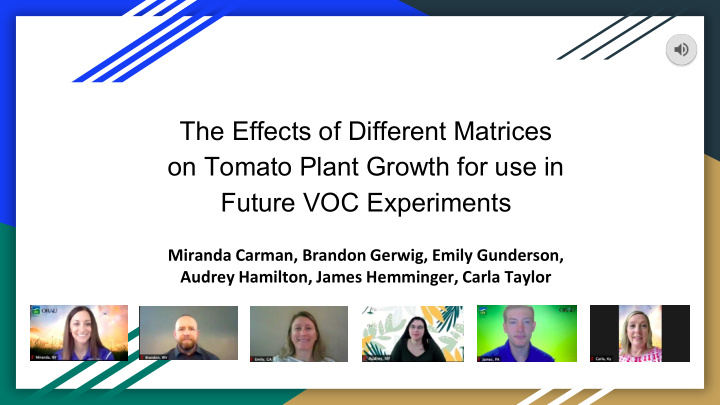



The Effects of Different Matrices on Tomato Plant Growth for use in Future VOC Experiments Miranda Carman, Brandon Gerwig, Emily Gunderson, Audrey Hamilton, James Hemminger, Carla Taylor
Introduction ● Tomatoes as a model organism ● Testing of growth media ● Traditional vs. Hydroponic method ● Different strains of tomatoes
Background ● Eucalyptus Emissions ● Combustible Biogenic Volatile Organic Compounds (BVOCs) ● Mass Produced Greenhouse Crops = Tomatoes ● Enhanced Growing Conditions ● Reduced Heating Costs, Water Consumption, Harmful Emissions ● Increased Growing Seasons, Crop Yield, Produce Quality ● Potential Alternative Energy Source
Materials ● Five 32 Oz Mason Jars ● Two Whatman Filter Papers 90 mm diameter ● Distilled water (1 L) ● Schenk and Hildebrandt Basal Salt Mixture ● Peat Moss Soil (2) ● Tomato Seeds - Roma (8 seeds) ● Tomato Seeds - Sweetie (8 seeds) ● 4 vented lids ● 1 closed lid ● Forceps
Methods 1. Dissolve Basal Salt Mixture into 1 L of distilled water. 2. Label jars: - Roma with filter - Roma with peat - Sweetie with filter - Sweetie with peat 3. Place materials in jars: - Peat moss soil in 2 jars - 1 filter paper in 2 separate jars 4. Pour Basal Salt Mixture into jars. - Peat: Enough to moisten soil (~50 ML) - Filter: Enough to cover the filter paper
Methods 5. Use forceps to place 4 seeds (roma and sweetie) into appropriate jars. Space seeds equally apart and 1 inch from edge of jar. 6. Close jars with vented lids and place in location with indirect sunlight. 7. Monitor daily and collect observations. Record length of shoots and roots in data table (mm). 8. Calculate the average length of shoots and roots for each jar after 10 days.
Setup/Location of Experiments
Progress Pictures - W eek 1
Progress Pictures - W eek 2
Growth Data Averages Roma R-F Sweetie R-F Roma R-P Sweetie R-P Roma S-F Sweetie S-F Roma S-P Sweetie S-P Day 1 0 0 0 0 0 0 0 0 Day 2 0 0 0 0 0 0 0 0 Day 3 0.75 0.07 0.19 0.19 0 0 0 0 Day 4 4.74 1.75 4.06 0.94 1.91 2 1.625 1.375 Day 5 14.43 6.89 N/A N/A 7.62 5.46 13.93 12.91 Day 6 19.5 13.1 N/A N/A 19.38 12.97 27.69 21.58 Day 7 31.7 23.62 N/A N/A 31.01 23.17 40.39 34.18 Day 8 38.06 30.54 N/A N/A 53.04 33.94 53.53 48.06 Day 9 50.12 36.7 N/A N/A 64.48 39.79 59.48 54.66 Key Root and shoot growth were averaged from 7 participants R Root Growth measurements for days 1 - 9. S Shoot Growth F Whatman #1 Filter Paper All measurements are in millimeters. P Peat Pellet
Analysis
Analysis Tomato Type & Matrix Slope Value Roma R - F 0.926 Sweetie R-F 0.891 Roma R - P 0.637 Sweetie R - P 0.754 Roma S - F 0.843 Sweetie S - F 0.868 Roma S - P 0.905 Sweetie S - P 0.898 Key R Root Growth S Shoot Growth F Whatman #1 Filter Paper P Peat Pellet
Conclusion This experiment, as proposed, investigates the effects of different matrices on tomato plant growth for use in future experiments. After 9 days of growth, the filter paper showed the greatest amount of root growth for both tomato species. The Roma had an average root growth rate of 0.926 mm/day and the Sweetie had an average root growth rate of 0.891 mm/day. With respect to shoot growth, the peat pellets demonstrated the greatest growth with 0.905 mm/day for the Roma and 0.898 mm/day for the Sweetie. Determinate tomatoes, such as Roma, will reach a peak height within a certain timeframe and bear fruit all at once. Indeterminate tomatoes, such as Sweetie, will continue to grow and bear fruit throughout the growing season. Having this variety will give greenhouse growers more flexibility in establishing a set growing schedule. Based on the data, the filter paper showed the greatest initial growth for the root systems, indicating that this could be a viable medium for starting tomato plants prior to moving to peat pods to encourage shoot growth. The implications, provided by the results, can extend into further study of VOC emissions to extend growing seasons while generating a reduction in energy cost and consumption.
Further Research ● Potential Benefits of Harnessing Plant-Based VOCs ● Types of VOCs Produced ● Means of Harvesting VOCs ● Calculating Carbon as a Commodity ● Aiding Economic Advancement
Tomato Power Process
cis -3-hexen-1-ol Controls ● Will the cis-3-hexen-1-ol react with the tin oxide sensor? ● Will a realistic dilution of cis-3-hexen-1-ol produce a response by the tin oxide sensor?
VOCs - Experiment with Roma Tomatoes Light Comes On
Sources 1. Rasband, W.S., ImageJ, U. S. National Institutes of Health, Bethesda, Maryland, USA, https://imagej.nih.gov/ij/, 1997- 2020. 2. Vivaldo, G., Masi, E., Taiti, C. et al. The network of plants volatile organic compounds. Sci Rep 7, 11050 https://www.nature.com/articles/s41598-017-10975-x#Abs1 (2017). https://doi.org/10.1038/s41598-017-10975-x
Acknowledgements Thank you for your support!
Recommend
More recommend